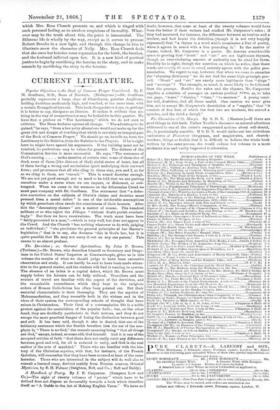A Handbook of Poetry. By J. E. Carpenter. (Sampson Low
and Co.)—The sight of twenty volumes of "poetry" which have to be noticed does not dispose us favourably towards a book which describes itself as "A Guide to the Art of Making English Verse." We have no doubt, however, that some at least of the twenty volumes would have been the better if their writers had studied Mr. Carpenter's rules ; if they had mastered, for instance, the difference between an iambus and a trochee, and had learnt the definition (though it is not very happily expressed) that "a rhyme is a word which terminates a line of poetry, when it agrees in sound with a line preceding it." In the matter of rhyme, indeed, Mr. Carpenter is a purist. He devotes considerable space to proving that "heart" and " art " are not legitimate rhymes, though an overwhelming amount of authority can be cited for them. Possibly he is right, though the assertion on which he relies, that these words are exactly the same in sound, scarcely agrees with the polite pro- nunciation. We regret to say, however, that when we come to examine the "rhyming dictionary " wo do not find the same high principle pre- vail. " Heart " and "art" are surely more legitimate than "dirge" and "scourge"? The example, as usual, is moro likely to be followed than the precept. Besides the rules and the rhymes, Mr. Carpenter supplies a selection of passages on various poetical rbrol, as, to take one page, "tears," "thanks," "time," "to-morrow." A young versi- fier will, doubtless, find all those useful. One caution we must give him, not to accept Mr. Carpenter's description of a " sapphic," that "it consists of five feet, of which the first two are trochees, the second a spondee, and the third a dactyl."






































 Previous page
Previous page